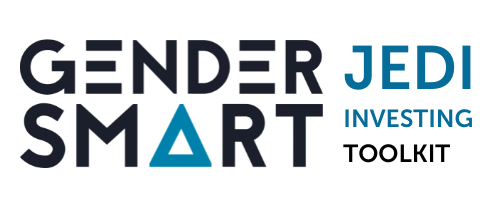The Impact of Systemic Barriers and Power
What seem like objective tools of the trade for many investors and intermediaries, existing financial structures and analysis can actually screen out minority entrepreneurs and fund managers. In this section, we synthesise how these biases and barriers are manifesting in the private and public markets context, and also spotlight some key concepts around power. We believe by internalising these concepts and dimensions, allocators and intermediaries can deconstruct and examine the investment process and outcomes, thereby taking major steps forward in enacting gender + JEDI principles.
Private Markets
Pipeline Bias
If organisations are largely relying on internal and advisor networks to identify potential investment opportunities, it’s likely that the capital seekers in those networks come from similar backgrounds. Expanding those networks and bringing in consultants specialising in gender + JEDI will bring in more diverse candidates.
Accelerators, incubators, and hubs are feeders for many pipeline strategies, but are not always inclusive. Reasons include recruitment, selection biases, program design, and culture. For example, women and minorities do not participate in high-tech incubators and accelerators at the same rates as their white, male counterparts.
Illumen Capital and Stanford SPARQconducted a peer-reviewed study, Race Influences Professional Investors’ Financial Judgments, examining the differences in judgment when all details about a fund’s track record and qualifications were kept constant except race. The results suggest first that underrepresentation of Black managers in investing is not only a pipeline problem but a bias problem. Second, that funds led by Black men might paradoxically face the most barriers to advancement after they have established themselves as strong performers.
Due Diligence and Investment Criteria
Credit scores tend to work against people without access to traditional banking and financing, as well as those from disadvantaged backgrounds.
Overly burdensome due diligence questionnaires presume that founders and fund managers have the time and resources to spend. Women and those from minority backgrounds typically spend more time than their white male counterparts completing them to overcome the perception of risk. These diverse capital seekers often lack large savings to survive on while fundraising, and drawn-out investment processes have a disproportionately negative impact on these groups. Instead, consider using a standardised due diligence questionnaire, such as ILPA’s.
Requiring a founder to have “skin in the game” excludes those without intergenerational wealth or access to high-wealth networks, which is often true of those from marginalised backgrounds (as addressed in Due Diligence 2.0).
Similarly, requiring fund teams to have “worked together” and “invested together” previously assumes personal, intergenerational, and/or network wealth, often screening out those from underrepresented groups.
First time funds are often perceived as “high risk,” even though the datashowsotherwise. Fund managers from underrepresented groups, who are disproportionately excluded from large firms, often don’t have the track record required to overcome this hurdle.
Setting $100 million-plus minimum-target fund size requirements often has the effect of filtering out women and diverse fund managers, who typically have smaller raises.
Looking solely at manager assets under management (AUM) to evaluate financial stability excludes other, potentially more reliable and more equitable metrics, such as growth momentum in AUM, AUM growth in previous positions, and others.
Tracy Gray and Emilie Cortes instead suggest relying on track record alternatives, such as “domain expertise, operational experience, deep knowledge, differentiation, and other risk-mitigation strategies” to fairly assess risk.
These are just some of the ways in which common due diligence processes disadvantage minority groups. See our collection of due diligence resources [link here] to explore how to unblock investment process to women and underrepresented groups.
Public Markets
Discounting Social Justice as an Investment Criteria
Public markets have immense power and large-scale impact. We have a responsibility to consider that impact when investing. Failing to consider how our values can align with our investment criteria is a missed opportunity, and can prevent early indicators of material and reputational risk coming to light. There are numerous publicly-traded companies whose practices exacerbate systemic racial injustice such as those listed in Adasina Social Capital’s Racial Justice Impact Data Set.
Making the proactive decision to back institutions promoting social justice might mean investing in community development financial institutions (CDFIs) and minority depository institutions (MDIs), which are important resources for small businesses in Black and LatinX communities.
Pay attention to campaigns and initiatives shining a light on companies’ practices or work cultures which perpetuate systemic injustice. One example is the Force the Issue project, which looks to end forced arbitration for sexual harassment claims.
Focusing on Numbers
Simply counting the number of diverse employees alone will not get to a more equitable financial model.
Instead, try to get deeper insight into whether a company’s workplace is truly inclusive, such as by using the Equileap Gender Equality Scorecard criteria. Or consider bringing an intersectional view to the investment process using tools such as Ethos, which provides scoring for investments on key impact areas such as gender equality, racial justice, and climate change.
‘Power With’ versus ‘Power Over’
Often, diversity initiatives are described as “empowering” women and minorities. Yet the word “empower” is defined as: “to give power or authority to.” So in order to empower someone, power must be given tothem by another who already has it. One who wants to be empowered isn’t given the agency to create power on their own. This dynamic cannot truly lead to equity.
Inspired by this paper, we have extrapolated a gender-and-JEDI transformative approach toward transforming power dynamics and unequal structures. True power-sharing is not about tick-box exercises meant to put a band-aid on the problems, but addresses “the social norms, attitudes, behaviours, and social systems that underlie them” by looking critically at power relations. Rebalancing power dynamics is a collective responsibility.
The Four Dimensions of Power
Power over: Control over people, resources and others’ lives
Power to: Acting and realizing one’s aspirations, directly related to the agency dimension of empowerment and frequently measured in terms of individual skills, capacities and self-confidence
Power within: A person’s or group’s sense of self-worth, self- awareness, self-knowledge and aspirations, which are also related to agency and shaped by social norms and institutions
Power with: Collaborative and collective power with others through mutual support, collaboration, recognition and respect for differences.
Implicit Bias in Investment Decision Making
The implicit biases of investment staff and asset managers can be a major roadblock to funding more women and individuals from underrepresented groups. There are concrete steps an organization can take to reduce these biases:
Work with a specialised consultant to build implicit bias training into the organisation’s decision-making progress, including in investment staff training.
Require fund managers to undergo implicit bias training - or otherwise give a clear statement about their diversity and inclusion initiatives with measurable targets - as a condition of investment, and require the same of asset managers.
Make sure those in the investment decision-making process understand the reality of behavioural finance, behavioural economics, and privilege - appreciating the underlying realities behind implicit bias training is critical to its effectiveness.

